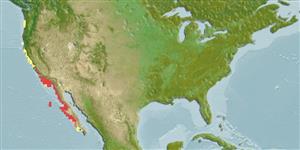>
Perciformes/Serranoidei (Groupers) >
Serranidae (Sea basses: groupers and fairy basslets)
Etymology: Paralabrax: Greek, para = the side of + Greek, labrax, -akos = a fish, Dicentrarchus labrax (Ref. 45335).
More on author: Girard.
Environment: milieu / climate zone / profondeur / distribution range
Écologie
marin benthopélagique; profondeur 1 - 61 m (Ref. 96339), usually 3 - 25 m (Ref. 32351). Subtropical; 48°N - 23°N, 126°W - 109°W
Eastern Pacific: Columbia River in Washington, USA to southern Baja California, Mexico.
Taille / Poids / Âge
Maturité: Lm ? range ? - ? cm
Max length : 72.0 cm TL mâle / non sexé; (Ref. 2850); poids max. publié: 7.0 kg (Ref. 9342); âge max. reporté: 34 années (Ref. 56049)
Usually found in or near kelp beds, shallow water and to about 50 m but mostly from 2.4-21m . Found throughout water column. Large specimens usually occur in deeper water. Juveniles feed on benthic invertebrates (especially crustaceans); adults feed on fishes and cephalopods (Ref.9342). Both juveniles and adults may feed on plankton when abundant (Ref.9342). Pelagic spawners (Ref. 56049). Also caught with troll lines (Ref. 9342). Excellent food fish and an important game fish (Ref. 9342).
Pelagic spawner (Ref. 56049). Spawning aggregations are a significant component of the reproductive behavior of this species (Ref. 59326). Also Ref. 103751.
Eschmeyer, W.N., E.S. Herald and H. Hammann, 1983. A field guide to Pacific coast fishes of North America. Boston (MA, USA): Houghton Mifflin Company. xii+336 p. (Ref. 2850)
Statut dans la liste rouge de l'IUCN (Ref. 130435: Version 2025-1)
Menace pour l'homme
Harmless
Utilisations par l'homme
Pêcheries: commercial; pêche sportive: oui
Outils
Articles particuliers
Télécharger en XML
Sources Internet
Estimates based on models
Preferred temperature (Réf.
123201): 12 - 20.1, mean 14.8 °C (based on 12 cells).
Phylogenetic diversity index (Réf.
82804): PD
50 = 0.5020 [Uniqueness, from 0.5 = low to 2.0 = high].
Bayesian length-weight: a=0.00933 (0.00441 - 0.01974), b=3.05 (2.88 - 3.22), in cm total length, based on LWR estimates for this species & Genus-body shape (Ref.
93245).
Niveau trophique (Réf.
69278): 3.9 ±0.4 se; based on diet studies.
Generation time: 10.7 ( na - na) years. Estimated as median ln(3)/K based on 1
growth studies.
Résilience (Réf.
120179): Faible, temps minimum de doublement de population : 4,5 à 14 années (K=0.10; tm=2.5; tmax=34).
Fishing Vulnerability (Ref.
59153): High to very high vulnerability (67 of 100).
🛈
Nutrients (Ref.
124155): Calcium = 36.5 [15.5, 73.9] mg/100g; Iron = 0.698 [0.381, 1.332] mg/100g; Protein = 17.7 [15.9, 19.4] %; Omega3 = 0.305 [0.171, 0.541] g/100g; Selenium = 28.9 [12.5, 60.3] μg/100g; VitaminA = 34.4 [10.0, 127.5] μg/100g; Zinc = 0.695 [0.494, 1.018] mg/100g (wet weight);
